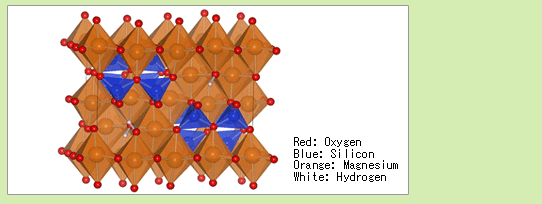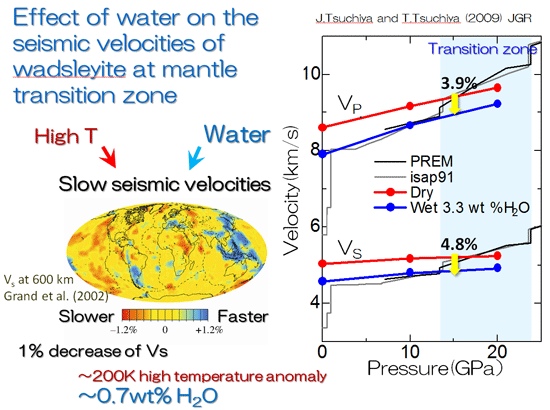1. Structure and elastic properties of nominally anhydrous minerals (NAMs).
Existence of water in the deep mantle may significantly affect the mantle dynamics, because the physical
properties of mantle minerals such as atomic diffusivity, melting temperatures, and elasticity of the mantle
constituent minerals are considerably changed by the presence of water. Many high pressure and temperature
experiments have been conducted in order to know whether the mantle constituent mineral can retain water
in
the earth’s deep interiors It was reported experimentally that up to a few wt%H2O can be dissolved in
wadsleyite
and ringwoodite, which are believed to be the primarily component of the mantle transition zone.
(e.g., up to ~2 wt% at 1000-1200°C, and ~0.5 wt% at 1600°C at the transition zone pressures (Ohtani et al. 2001)).
Therefore, if the hydrous minerals in subducting cold slab could transport water into the mantle transition zone,
there is a possibility that significant amount of water is stored in wadsleyite and ringwoodite in the mantle
transition zone.
If such amount of water exists in wadsleyite and ringwoodite in the mantle transition zone,
it should in principle be detected
by the seismic observations. In order to determine the amount of water
in the deep earth, the dependence of elastic moduli
on water content of these minerals at high pressure
conditionsas well as precise observation of seismic velocities is indispensable.


In order to clarify the effect of protonation of wadsleyite under high-pressure conditions,
we determined defect structures of
Mg1.875SiO4H0.25(1Mg2+ ←→ VMg2- + 2H+, 1.65 wt % H2O),
Mg1.75SiO4H0.5 (2Mg2+ ←→ 2VMg2- + 4H-, 3.3 wt % H2O) hydrous wadsleyite and
their elastic properties by means
of the density functional first principles method.
Structural optimization calculations indicate
that the most stable structures have monoclinic symmetry
with magnesium M3 site vacancies. Protons are found to bond to the O1 site
to align the OH dipoles along
the edges of M3 vacancies. Calculated elastic constants, bulk and shear moduli, are found to decrease
almost
linearly with increasing water content but to increase linearly with increasing pressure. At 15 GPa and static
0 K condition,
incorporation of 3.3 wt % H2O into wadsleyite, which corresponds to the maximum solubility
of hydrous wadsleyite, reduces VP and VS
by about 3.9 and 4.8%, respectively. This indicates that 1 wt % H2O
hydration of wadsleyite corresponds to the temperature effects
on bulk and shear moduli about 430 K (0 GPa)
to 340 K (20 GPa) and 350 K (0 GPa) to 290 K (20 GPa), respectively. The transversely
isotropic aggregates
demonstrate largest positive polarization anisotropy VSH - VSV when the c axis aligns vertically in both dryand wet cases.

More detail, see: Jun Tsuchiya and Taku Tsuchiya, First principles investigation of the structural
and elastic properties of
hydrous wadsleyite under pressure.
JOURNAL OF GEOPHYSICAL RESEARCH, VOL. 114, B02206, doi:10.1029/2008JB005841, 2009





